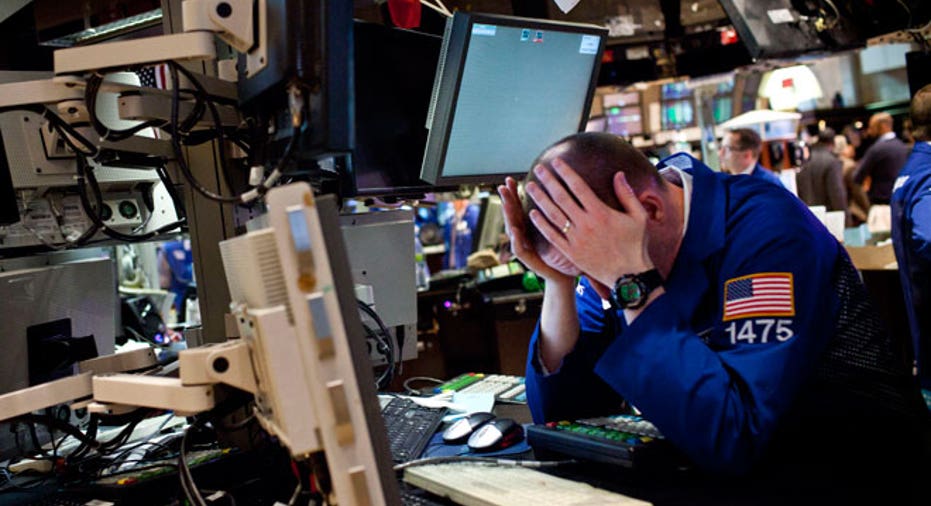Wall Street Slammed Amid Global-Growth Fears

U.S. equity markets capped a tumultuous trading day solidly in negative territory after shedding about $812 billion in market value.
The Dow Jones Industrial Average wiped out 588 points, or 3.58% to 15871. The S&P 500 dropped 77 points, or 3.94% to 1893, while the Nasdaq plunged 179 points, or 3.82% to 4526.
All ten S&P 500 sectors were in negative territory, with energy declining the most, dropping 5.18% on the session.
Today’s Markets
The Dow saw its biggest-ever intraday point drop on Monday at the opening bell as it plunged 1,089 points. By the close of trade, all three major U.S. averages were in correction territory, though well off session lows.
A weekend to digest growing global economic-growth concerns failed to settle nerves on Wall Street as U.S. equities extended a selloff in global markets amid heightened fear about significant deterioration in China. The concern came as traders wondered if there will be another shoe to drop from Chinese officials looking to stem the market’s bleeding. The world’s second-largest economy moved two weeks ago to devalue its currency, the yuan, on the heels of continued weakness in its economic data.
Peter Kenny, chief market strategist at Clearpool Group, called the action in global markets dramatic and gut wrenching.
“China is definitely the No. 1 cause for concern globally and Europe is not far behind,” Kenny said. “The speed at which this market has moved sharply lower is an indication panic is driving all investment decisions. If you haven’t positioned yourself for volatility and seasonal weakness, you’re behind the 8 ball.”
China’s Shanghai Composite Index plummeted more than 9% during the session Monday, and closed down 8.5% pushing equity markets in Asia to give up their 2015 gains. Hong Kong’s Hang Seng tumbled 5.17%, while Japan’s Nikkei dropped 4.61%.
As the carnage spread, European equity markets didn’t fare much better, though major averages there gained back some lost ground before the close of trade. The Euro Stoxx 50, which tracks large-cap companies in the eurozone, declined 5.02%, plunging further into correction territory after notching its worst week in four years last week. The German Dax shed 4.31%, while the French CAC 40 sank 5.12%, and the UK’s FTSE 100 dropped 4.33%.
August is typically known as a quiet month for action in the equity markets as investors seek relaxation amid summer’s last days. However, this year is an exception to the rule. The CBOE VIX Index, Wall Street’s closely-watched gauge of investor anxiety, touched 53.29, its highest level in 6-1/2 years on Monday, while NYSE composite volume ran at about 90% above the one-month average.
As the major averages plunged, so too did 20 of 30 stocks in the Dow, including Chevron (NYSE:CVX), Caterpillar (NYSE:CAT), Wal-Mart (NYSE:WMT), and Apple (NYSE:AAPL) which hit fresh 52-week lows before bouncing back late in the session.
Investors might be tempted to dip their toes in the discounted waters at this point, and Kenny said it’s important for them to look for valuation amid the volatility –he said this correction is likely not the end of the bull market just yet.
“When valuations compress from lofty levels that we’ve been trading at, those are where value investors tend to be more attracted to the market,” he said. “Valuation is what’s going to drive investors back in. Right now it feels like the end of the world. But it’s not.”
As for putting money to work right now, David Joy, chief market strategist at Ameriprise Financial, advised waiting on the sidelines until the market’s bottom is clearer.
“Stay out for now, but if you have cash long term, think about where you might want to put it to work and when,” he said. “If we end where we opened, we’ll have very nerve-inducing headlines that could cause further weakness. Begin to think what your strategy might be, but don’t execute yet.”
He continued by saying it’s not just about dramatic, one-day market moves, but the longer-term horizon. For the U.S., it’s when the Federal Reserve is likely to begin hiking rates and in what kind of environment. While the quadruple-digit plunge in the Dow causes investors to panic and then sell, Joy said it’s important to keep your eyes focused on what’s ahead.
“There’s a lot of important economic data in the U.S. and those will become important to stabilize the situation if they’re as strong as expected,” he said. “We get a GDP revision [on Thursday] and it’s expected to show the second-quarter was meaningfully stronger than the first estimate. Those will be important to stabilize and restore U.S. confidence.”
Commodities Crumble
Commodity markets couldn’t escape the bloodletting as crude prices sank to fresh six-year lows. U.S. crude dropped 5.46% to $38.24,while Brent, the international benchmark, declined 6.09 %to $42.69 a barrel. Both benchmarks hit fresh 52-week lows, while settling at the lowest levels since 2009.
“Oil prices have continued falling and even though they’ve been sitting in oversold territory for more than a week, the increasing doubts over China’s abilities to meet its 7% growth target is looking more and more unachievable,” IG Market Analyst Alastair McCaig said in a note.
Gold’s safe-haven status appeared to melt away Monday as the precious metal snapped a three-session win streak and dipped 0.53% to $1,153 a troy ounce. Silver dropped 3.52% to $14.76. Meanwhile, aluminum and copper hit their lowest levels since 2009.
In a flight to safety, traders snapped up 10-year U.S. Treasury bonds as the yield fell to the lowest level since April, declining 0.022 percentage point to 2.030%
In currencies, meanwhile, the euro jumped 1.63% against the U.S. dollar, while the greenback gained 0.24% against the Chinese yuan.